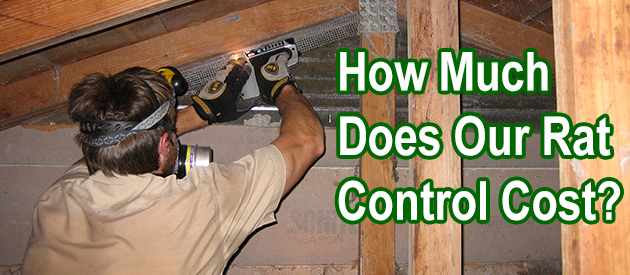Brown County, Green Bay Rat Control Situation:
David, We have had rat problems on and off for two years. We've caught more than 20 rats in our attic. Several maintenance men, exterminators, roofers and a general contractor have inspected our house. We've removed bushes, trimmed trees, covered vents on the roof, put covers on the bottoms of the gutter downspouts. We have a hole in our house wall by our sink where they have chewed and chewed. We calledyour Wildlife guy in Green Bay. He was wonderful and spent an hour or two on our house and didn't even charge us. But he can not find where the rats are coming in. NO ONE has been able to find out where our rats are coming into the attic. Everyone says it's not our roof; but I don't know that. Angel said he'd come back because he has another theory about rats going through the sewer and up the pipes. He's coming back on Wednesday. My problem is what will I do if Angel comes and says he still can't find anything? We are literally trapped in our house. We can't sell it and we don't want to live here. I read the horrors about rats on the internet and I feel totally hopeless. Apparently there are no government agencies that can/ will help. What can we do? We're 72 years old and planned to live here for the rest of our lives. You can't imagine the psychological stress we're under. Do you have any suggestions?
Hi David, I have a rat or rats in my attic and I need your help. I have an old house that i could not possibly seal up. There is just no way because of inaccessible crawl spaces,etc. I have tried the large glue traps but he seems to go around them now. I will try the Victor snap traps but I think I am dealing with a very smart rat. Should I bait the trap first and not set it so it gets comfortable eating PB off the trap? Also do the expensive electronic repellants work at all. Tractor Supply sells one for $50. Please help me. I'm losing too much sleep!
I found what I thought was rat poop in a closet. My exterminator said I had to insulate the entire attic with their special insulation that kills all creatures. There were no signs if entry to that area. After he left I moved a box and found a large Palmetto bug which moved very slowly. I killed it and now wonder if the black things are eggs or feces. No stains or smell was in the area. Please help!
Green Bay Rat Control Tip of The Week
Can A Rat Have Rabies?
Rats have powerful bites:
Rats can have very powerful bites and are capable of damaging the skin quickly. A rat can bite through cinderblocks to get into an area if it needs to. Rats could bite through clothing or manage to break the skin even unintentionally with a very quick bite. Handling rats with care or using heavy gloves is recommended if you have to remove one or relocate it. It is ultimately best if you avoid handling rats whenever possible.
Many people are bitten each year with low rates of infection:
Rats bite over 50,000 people in the USA each year. Rabies vaccine shots are very rarely delivered in these cases and the risk for other types of diseases that rats carry can be far greater. Going to see a doctor about a rat bite can be wise if you are starting to feel some of the secondary symptoms or it looks infected.
Rats do spread disease:
Rats do spread a series of diseases including rat-bite fever. It can be transmitted through a bite or through pets. Rabies can be a deadly disease but most of the diseases that rats pass on are only able to cause the chance for fever and infection which carry lower rates of mortality.
Other animals can be much riskier to receive bites from:
If you are bitten by other animals like raccoons, coyotes, woodchucks, or skunks, this will give you a much riskier chance of receiving something like rabies. When bitten by a rat, you should be concerned but you may not have to run to get the bite checked out with the same urgency.
The main theory of low rabies cases:
A rat would have to survive a bite from a predator in order to become a carrier of rabies. As coyotes and larger animals will be likely to kill a rat in an attack, this leads to the chance of rats not being able to spread rabies at all.


